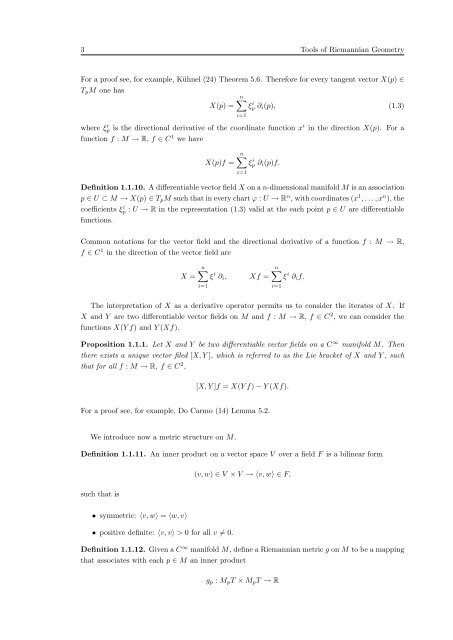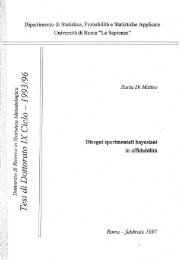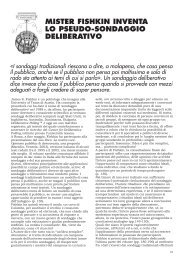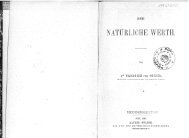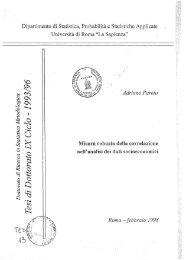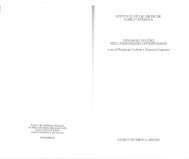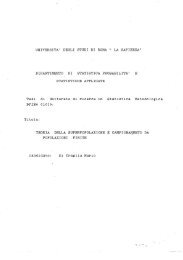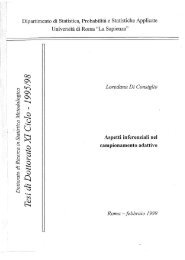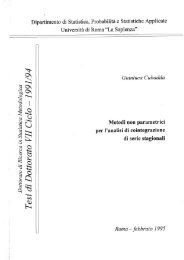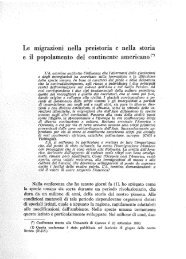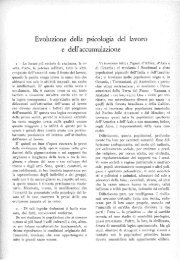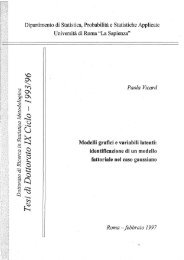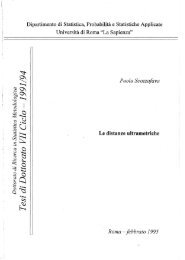Random Processes in Hyperbolic Spaces Hyperbolic Brownian ...
Random Processes in Hyperbolic Spaces Hyperbolic Brownian ...
Random Processes in Hyperbolic Spaces Hyperbolic Brownian ...
Create successful ePaper yourself
Turn your PDF publications into a flip-book with our unique Google optimized e-Paper software.
3 Tools of Riemannian Geometry<br />
For a proof see, for example, Kühnel (24) Theorem 5.6. Therefore for every tangent vector X(p) ∈<br />
TpM one has<br />
n<br />
X(p) =<br />
i=1<br />
ξ i p ∂i(p), (1.3)<br />
where ξ i p is the directional derivative of the coord<strong>in</strong>ate function x i <strong>in</strong> the direction X(p). For a<br />
function f : M → R, f ∈ C 1 we have<br />
X(p)f =<br />
n<br />
i=1<br />
ξ i p ∂i(p)f.<br />
Def<strong>in</strong>ition 1.1.10. A differentiable vector field X on a n-dimensional manifold M is an association<br />
p ∈ U ⊂ M → X(p) ∈ TpM such that <strong>in</strong> every chart ϕ : U → R n , with coord<strong>in</strong>ates (x 1 , . . . , x n ), the<br />
coefficients ξ i p : U → R <strong>in</strong> the representation (1.3) valid at the each po<strong>in</strong>t p ∈ U are differentiable<br />
functions.<br />
Common notations for the vector field and the directional derivative of a function f : M → R,<br />
f ∈ C 1 <strong>in</strong> the direction of the vector field are<br />
X =<br />
n<br />
ξ i ∂i, Xf =<br />
i=1<br />
n<br />
ξ i ∂if.<br />
The <strong>in</strong>terpretation of X as a derivative operator permits us to consider the iterates of X. If<br />
X and Y are two differentiable vector fields on M and f : M → R, f ∈ C 2 , we can consider the<br />
functions X(Y f) and Y (Xf).<br />
Proposition 1.1.1. Let X and Y be two differentiable vector fields on a C ∞ manifold M. Then<br />
there exists a unique vector filed [X, Y ], which is referred to as the Lie bracket of X and Y , such<br />
that for all f : M → R, f ∈ C 2 ,<br />
i=1<br />
[X, Y ]f = X(Y f) − Y (Xf).<br />
For a proof see, for example, Do Carmo (14) Lemma 5.2.<br />
We <strong>in</strong>troduce now a metric structure on M.<br />
Def<strong>in</strong>ition 1.1.11. An <strong>in</strong>ner product on a vector space V over a field F is a bil<strong>in</strong>ear form<br />
such that is<br />
• symmetric: 〈v, w〉 = 〈w, v〉<br />
• positive def<strong>in</strong>ite: 〈v, v〉 > 0 for all v = 0.<br />
(v, w) ∈ V × V → 〈v, w〉 ∈ F,<br />
Def<strong>in</strong>ition 1.1.12. Given a C ∞ manifold M, def<strong>in</strong>e a Riemannian metric g on M to be a mapp<strong>in</strong>g<br />
that associates with each p ∈ M an <strong>in</strong>ner product<br />
gp : MpT × MpT → R


